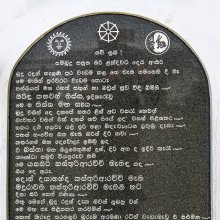Diri, Ḍirī: 3 definitions
Introduction:
Diri means something in Marathi, biology. If you want to know the exact meaning, history, etymology or English translation of this term then check out the descriptions on this page. Add your comment or reference to a book if you want to contribute to this summary article.
Images (photo gallery)
Biology (plants and animals)
Source: Google Books: CRC World Dictionary (Regional names)1) Diri in Ivory Coast is the name of a plant defined with Anchomanes difformis in various botanical sources. This page contains potential references in Ayurveda, modern medicine, and other folk traditions or local practices It has the synonym Caladium petiolatum Hook. (among others).
2) Diri in Mali is also identified with Vetiveria nigritana It has the synonym Chrysopogon nigritanus (Benth.) Veldkamp (etc.).
Example references for further research on medicinal uses or toxicity (see latin names for full list):
· Austrobaileya (1999)
· Bulletin du Muséum National d’Histoire Naturelle (1919)
· Genera Aroidearum exposita (1858)
· Flora of Tropical Africa (1917)
· Botanical Magazine, or ‘Flower-Garden Displayed’
· Rumphia (1837)
If you are looking for specific details regarding Diri, for example health benefits, extract dosage, chemical composition, diet and recipes, side effects, pregnancy safety, have a look at these references.

This sections includes definitions from the five kingdoms of living things: Animals, Plants, Fungi, Protists and Monera. It will include both the official binomial nomenclature (scientific names usually in Latin) as well as regional spellings and variants.
Languages of India and abroad
Marathi-English dictionary
Source: DDSA: The Molesworth Marathi and English Dictionaryḍirī (डिरी).—f (Dim. of ḍirā) A young sprout or shoot; an unopened spike of leaves; a spike (as of the milk-bush &c.) v phuṭa, nigha. 2 The follicle or seed-case of the radish.
Source: DDSA: The Aryabhusan school dictionary, Marathi-Englishḍirī (डिरी).—f A young sprout or shoot; an un- opened spike of leaves.
Marathi is an Indo-European language having over 70 million native speakers people in (predominantly) Maharashtra India. Marathi, like many other Indo-Aryan languages, evolved from early forms of Prakrit, which itself is a subset of Sanskrit, one of the most ancient languages of the world.
See also (Relevant definitions)
Starts with (+146): Diri cham pair, Diridamu, Diridire, Dirime, Dirimo ako, Dirin-da-rani, Diringa, Dirinimble, Dirinishi, Diriou doubou, Diripaka, Diriri, Dirisana, Dirisanamu, Dirisena, Dirishanam, Dirissanamu, Dirisu, Dirita, Diriya.
Ends with (+97): Abandiri, Alardiri, Apimanastiri, Araneri-cantekacastiri, Atamdiri, Bediri, Bhandiri, Calastiri, Cankuttiri, Cantanattiri, Caratutiri, Carikaittiri, Carukutiri, Castiri, Catiri, Cekkil-ittutiri, Cekkil-vaittutiri, Chandiri, Chuvannamundiri, Cirpacastiri.
Full-text: Zeb a diri, Diri cham pair.
Relevant text
Search found 2 books and stories containing Diri, Ḍirī; (plurals include: Diris, Ḍirīs). You can also click to the full overview containing English textual excerpts. Below are direct links for the most relevant articles:
Yoga Vasistha [English], Volume 1-4 (by Vihari-Lala Mitra)
Chapter XVI - Ontology of the self existent sat = being < [The om tat sat]
Jnaneshwari (Bhavartha Dipika) (by Ramchandra Keshav Bhagwat)
Verse 15.1 < [Chapter 15 - Purusottama-yoga]
